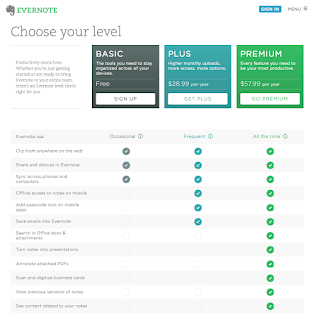I have come across Evernote periodically over the years, but I have never looked into until now. I had an idea that it was related to document creation (hence, Evernote), but more details emerged as I researched it.
Evernote is a note creation service that allows its users to share their notes with other Evernote users, and they can be accessed from any internet-enabled device (smartphone, tablet, desktop/laptop computer).
Evernote, when using a computer operating using Mac OS X or Windows, can be downloaded from the Evernote website (or the App Store on Mac OS X). If a user has an iOS or Android device, the user can download Evernote from their respective app marketplaces (i.e. Google Play or App Store).
When first opening the application, the user is prompted to create an Evernote account. Evernote requests a number of user information: a username, email, contact preferences, name, avatar, geographic location, devices using Evernote, phone number, and payment info if the user is willing to pay for more features.

All payment levels allow the user to screenshot anywhere on the web, share and discuss in Evernote, and sync across all devices using Evernote. Plus membership allows the user slightly more benefits, also allowing offline access and passcode locking on mobile applications, and saving emails into Evernote. Premium membership allows the user all the benefits of having a Basic and Plus account, but also allowing searching in Office docs and attachments, turning notes into presentations, creating annotations within PDF files, scanning/digitizing business cards, viewing previous versions of notes, and seeing content related to the user’s created notes. There is also a Business membership that allows the user access to Premium benefits alongside more sharing and collaboration opportunities within Evernote, and sharing and giving feedback on created notes.
Even though this application is geared mainly towards those in the business sector, this can also be used within the education sector for the same aforementioned reasons. The main reason why this application may be used among those in the business and education sectors is because of how simple it is to share notes among a common platform.
In the education sector specifically, this application can be used in Language Arts, possibly for procedural writing, short story creation, or poetry, though it can be used for more. Educational staff can also use it to share their ideas with each other to better their collective teaching.
As for if I would use it personally, although it provides a very simplistic, clean, crisp interface comparable to Pages (Mac OS X’s version of Microsoft Word), I don’t think I would use it right now. Pages and Apple’s native Notes application have been serving me very well, and they can be shared to other users, regardless of whether the recipient(s) use(s) an Apple device or not since it allows for documents to be exported in a variety of formats (PDF, Word, Pages, ePub, text). If I were suggested to in a future workplace, then I would certainly try it out, but right now, I don’t see any reason to be using yet another app for services that I have perfectly usable apps for anyways.
I’m sure that Evernote is a lovely application, but I would have to see if I would use it down the road. User setup is very straightforward and simple, but it’s not enough to have me migrate all of my files onto Evernote. I’d like to give it a try, though.


